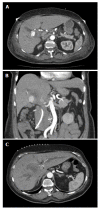Atypical presentation of a hepatic artery pseudoaneurysm: A case report and review of the literature
- PMID: 27366305
- PMCID: PMC4921800
- DOI: 10.4254/wjh.v8.i18.779
Atypical presentation of a hepatic artery pseudoaneurysm: A case report and review of the literature
Abstract
Classically, hepatic artery pseudoaneurysms (HAPs) arise secondary to trauma or iatrogenic causes. With an increasing prevalence of laparoscopic procedures of the hepatobiliary system the risk of inadvertent injury to arterial vessels is increased. Pseudoaneurysm formation post injury can lead to serious consequences of rupture and subsequent hemorrhage, therefore intervention in all identified visceral pseudoaneurysms has been advocated. A variety of interventional methods have been proposed, with surgical management becoming the last step intervention when minimally invasive therapies have failed. The authors present a case of a HAP in a 56-year-old female presenting with jaundice and pruritis suggestive of a Klatskin's tumor. This presentation of HAP in a patient without any significant past medical or surgical intervention is atypical when considering that the majority of HAP cases present secondary to iatrogenic causes or trauma. Multiple minimally invasive approaches were employed in an attempt to alleviate the symptomology which included jaundice and associated inflammatory changes. Ultimately, a right hepatic trisegmentectomy was required to adequately relieve the mass effect on biliary outflow obstruction and definitively address the HAP. The presentation of a HAP masquerading as a malignancy with jaundice and pruritis, rather than the classic symptoms of abdominal pain, anemia, and melena, is unique. This presentation is only further complicated by the absent history of either trauma or instrumentation. It is important to be aware of HAPs as a potential cause of jaundice in addition to the more commonly thought of etiologies. Furthermore, given the morbidity and mortality associated with pseudoaneurysm rupture, intervention in identifiable cases, either by minimally invasive or surgical interventions, is recommended.
Keywords: Biliary obstruction; Cholangitis; Hepatic artery pseudoaneurysm; Klatskin tumor; Trisegmentectomy.
Figures




Similar articles
-
Hepatic artery pseudoaneurysm-the Mayo Clinic experience and literature review.Front Med (Lausanne). 2024 Dec 10;11:1484966. doi: 10.3389/fmed.2024.1484966. eCollection 2024. Front Med (Lausanne). 2024. PMID: 39720662 Free PMC article.
-
Accessory Right Hepatic Artery Pseudoaneurysm Resulting in Biliary Obstruction.Case Rep Gastroenterol. 2023 Nov 28;17(1):346-355. doi: 10.1159/000535039. eCollection 2023 Jan-Dec. Case Rep Gastroenterol. 2023. PMID: 38033393 Free PMC article.
-
Iatrogenic pseudoaneurysms of the extrahepatic arterial vasculature: management and outcome.HPB (Oxford). 2006;8(6):458-64. doi: 10.1080/13651820600839993. HPB (Oxford). 2006. PMID: 18333102 Free PMC article.
-
Surgical Treatment Options of Subclavian Artery Pseudoaneurysms: A Case Report and Litterature Review.Rev Port Cir Cardiotorac Vasc. 2017 Jul-Dec;24(3-4):105-106. Rev Port Cir Cardiotorac Vasc. 2017. PMID: 29701339 Review.
-
Visceral artery pseudoaneurysms: two case reports and a review of the literature.J Med Case Rep. 2017 May 4;11(1):126. doi: 10.1186/s13256-017-1291-6. J Med Case Rep. 2017. PMID: 28472975 Free PMC article. Review.
Cited by
-
Atypical Presentation of Left Hepatic Artery Pseudoaneurysm.ACG Case Rep J. 2022 Jul 1;9(7):e00815. doi: 10.14309/crj.0000000000000815. eCollection 2022 Jul. ACG Case Rep J. 2022. PMID: 35784506 Free PMC article.
-
Massive Gastrointestinal Hemorrhage Due to an Arterioenteric Fistula From a Hepatic Artery Pseudoaneurysm.ACG Case Rep J. 2018 Mar 28;5:e26. doi: 10.14309/crj.2018.26. eCollection 2018. ACG Case Rep J. 2018. PMID: 29619401 Free PMC article.
-
'Whippled to death: an uncommon case of fatal gastrointestinal bleeding'.J Community Hosp Intern Med Perspect. 2020 Oct 29;10(6):560-561. doi: 10.1080/20009666.2020.1815462. J Community Hosp Intern Med Perspect. 2020. PMID: 33194129 Free PMC article. No abstract available.
References
-
- Lü PH, Zhang XC, Wang LF, Chen ZL, Shi HB. Stent graft in the treatment of pseudoaneurysms of the hepatic arteries. Vasc Endovascular Surg. 2013;47:551–554. - PubMed
-
- Finley DS, Hinojosa MW, Paya M, Imagawa DK. Hepatic artery pseudoaneurysm: a report of seven cases and a review of the literature. Surg Today. 2005;35:543–547. - PubMed
-
- Krokidis ME, Hatzidakis AA. Acute hemobilia after bilioplasty due to hepatic artery pseudoaneurysm: treatment with an ePTFE-covered stent. Cardiovasc Intervent Radiol. 2009;32:605–607. - PubMed
-
- Fankhauser GT, Stone WM, Naidu SG, Oderich GS, Ricotta JJ, Bjarnason H, Money SR. The minimally invasive management of visceral artery aneurysms and pseudoaneurysms. J Vasc Surg. 2011;53:966–970. - PubMed
Publication types
LinkOut - more resources
Full Text Sources
Other Literature Sources
Miscellaneous

